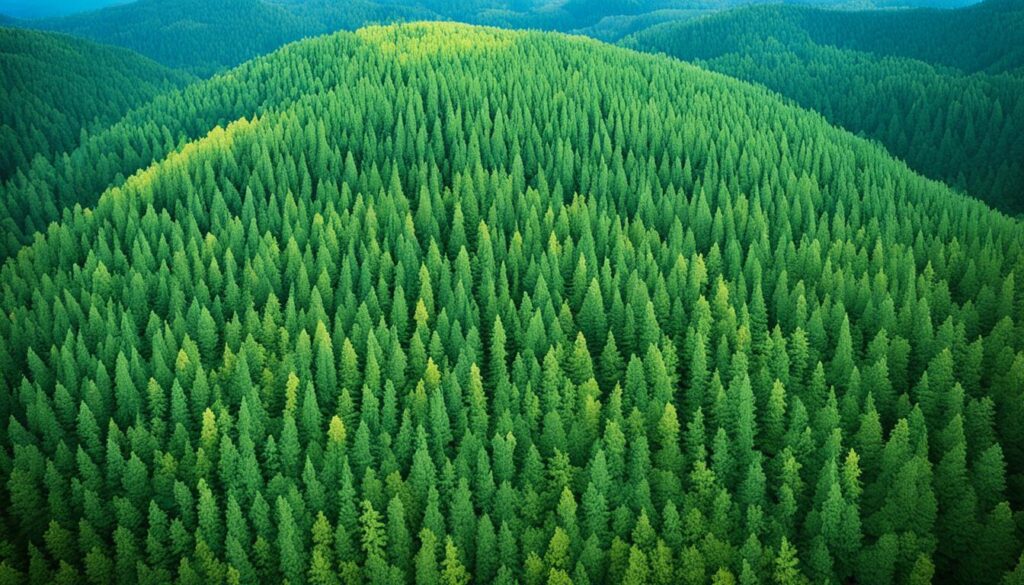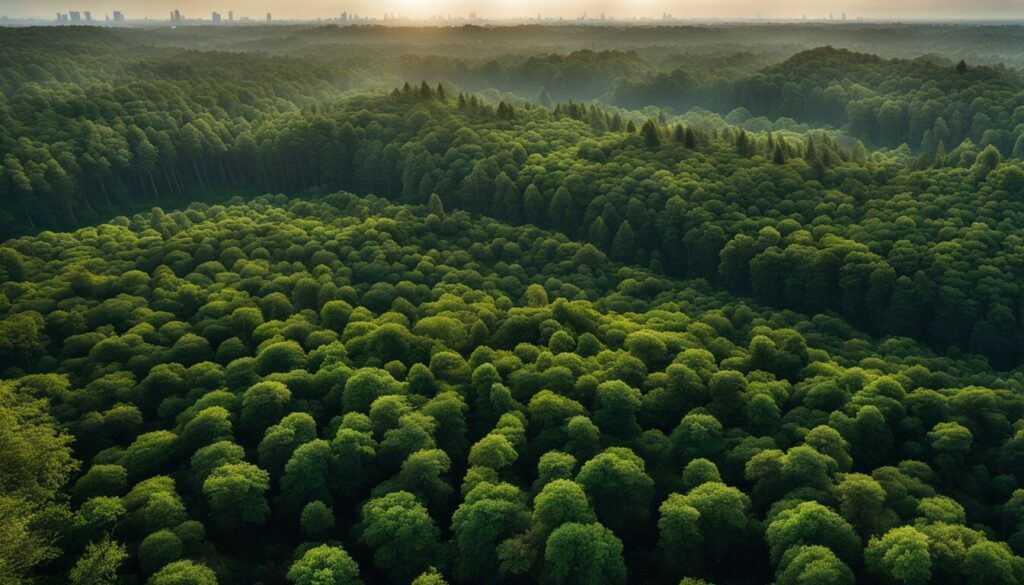Now, more than ever, the world faces big environmental problems. One key answer to these issues is reforestation. It’s the process of planting trees in areas where forests were cut down or lost. This method fights climate change, saves many plant and animal species, and helps keep the world’s systems in harmony. With many places suffering from the effects of having fewer trees, we’ll look at how going green again can make a huge difference globally.
Key Takeaways
- Reforestation is the process of replanting and restoring forested areas that have been depleted or destroyed.
- Reforestation plays a crucial role in combating climate change and preserving biodiversity.
- Deforestation has had significant environmental consequences, making reforestation a global priority.
- Reforestation strategies involve a range of approaches, from large-scale planting to natural regeneration.
- Governments and organizations worldwide are leading initiatives to drive reforestation efforts.
What is Reforestation?
Reforestation means planting trees to renew forests once they’ve been cut down or destroyed. It’s key for our planet’s health and to fight climate change.
Understanding the Importance of Reforesting
Forests are crucial for our climate. They absorb carbon dioxide and release oxygen. But when they disappear, the carbon they hold escapes into the air, causing global warming. Through reforestation, we trap this extra carbon, which lowers our carbon footprint and helps fight climate change.
Differentiating Reforestation from Afforestation
While reforestation and afforestation sound alike, they’re different. Afforestation plants new forests in places that were barren before. Reforestation, however, renews areas that once held forests. Both are important, but reforestation is vital for our ecosystem’s health.
| Reforestation | Afforestation |
|---|---|
| Replanting trees in areas where forests have been cleared or destroyed. | Establishing new forests in areas where they did not previously exist. |
| Restoring the balance of ecosystems and mitigating climate change. | Increasing the overall forest cover on the planet. |
| Focusing on areas that have lost their natural forest cover. | Targeting areas that were not previously forested. |
Knowing the different roles of reforestation and afforestation highlights why we must heal our forests. Their health is critical for a sustainable, thriving planet.
The Global Impact of Deforestation
Deforestation is a big problem in the world. It means clearing or destroying large areas of forests. The issue is so serious that its effects reach far beyond just the place being destroyed. It’s a problem for the whole planet.
Environmental Consequences of Deforestation
Deforestation has many bad effects on the environment. One big issue is the loss of biodiversity. Many kinds of plants and animals live in forests. When we cut down trees, they lose their homes. As a result, many species die out, hurting the natural balance.
Another major issue is the release of greenhouse gases. Trees absorb carbon dioxide. But when we cut them, this gas is released back into the air. It speeds up climate change, which leads to higher temperatures, melting ice caps, and more extreme weather.
Deforestation also causes soil erosion. Trees help keep the soil in place with their roots. When trees are gone, soil can wash away. This leads to poor land quality, clogged rivers, and less water. This water problem affects both people and animals.
“Deforestation is not just an environmental issue; it’s a human issue. When we destroy forests, we’re destroying the very foundation of life on our planet.”
The impact of deforestation goes beyond the environment. It shows why we must work together to fight this issue. We need to take serious action for our planet’s future.
Benefits of Reforestation
Reforestation brings many wonderful benefits that go beyond the forest’s edge. It helps fight climate change by adding green spaces and saving the plant and animal life that live there.
Combating Climate Change
Trees are key in fighting climate change. They suck in harmful carbon dioxide, a main player in global warming. This helps keep our Earth’s climate stable. Bringing back trees is a big part of lowering pollution from activities like driving and manufacturing.
Preserving Biodiversity
Adding trees also helps bring back diverse plant and animal life. This is crucial for species that have lost their homes due to deforestation. It makes sure the natural world is balanced and strong.
| Benefits of Reforestation | Description |
|---|---|
| Climate Change Mitigation | Forests act as natural carbon sinks, absorbing and storing atmospheric carbon dioxide, thereby reducing greenhouse gas emissions and helping to regulate the global climate. |
| Biodiversity Conservation | Reforestation efforts provide critical habitats for a wide range of plant and animal species, supporting the overall health and resilience of ecosystems. |
| Soil and Water Protection | Forests play a crucial role in preventing soil erosion, regulating water cycles, and improving water quality, contributing to the sustainable management of natural resources. |
| Local Livelihood Support | Reforestation projects can create jobs and economic opportunities for communities, particularly in developing regions, supporting sustainable development and poverty alleviation. |
Planting trees helps us build a better future. It means healthier forests and benefits that everyone, and everything, enjoys.
Reforestation Strategies
To successfully reforest an area, strategic plans are a must. This includes letting nature regrow by itself or planting trees actively. Each method is chosen for the spot it fits in best. Knowing these ways helps fight deforestation globally and brings back our important forests.
Natural Regeneration: Harnessing Nature’s Power
Natural regeneration is a money-saving and planet-friendly method. It works by letting the land heal on its own where forests used to be. Things like seeds spreading naturally and young plants growing help a forest rebound. By setting the right environment, this method helps native trees grow back. This makes the forest stronger and more varied over time.
Assisted Natural Regeneration: Guiding the Process
If nature needs a little push to regrow, assisted natural regeneration steps in. This involves helping and watching natural regrowth, like cleaning out plants that don’t belong or protecting young trees. By guiding the land to recover on its own, forests get back faster.
Active Planting: Targeted Reforestation
Sometimes, direct tree planting is needed to start the process. This method picks and prepares young trees, then puts them in the ground where forests are missing. It’s crucial in areas that can’t regrow by themselves quickly. This active step helps make a new healthy forest faster.
Choosing the right strategy is based on the area’s climate, soil, what resources are around, and the project’s goals. Mixing different methods for a specific place can make reforestation work best. Doing this helps reach the big goal of growing back Earth’s lost forests.

“Reforestation is not just about planting trees – it’s about restoring the delicate balance of our ecosystems and ensuring a sustainable future for generations to come.”
Reforestation Projects Around the World
Reforestation efforts are happening all over the globe. Many projects are fighting climate change, saving plant and animal life, and making the Earth green again.
Restoring the Amazon Rainforest
The Amazon is known as our planet’s “lungs”. It’s been hit hard by deforestation. But, the Amazon Reforestation Project is turning things around. It’s planting over 2 million trees. This work is restoring the forest and helping local people.
Greening the Sahel Region
The Sahel, a dry region in Africa, is losing its important plants and animals. The Great Green Wall project is fighting this. It plans to fix 100 million hectares of land by 2030. People are planting trees that can live in dry areas. They are also learning to take care of the land better.
Mangrove Restoration in Southeast Asia
Mangroves are life-savers for those living by the sea. They protect against big waves and help fight climate change by keeping carbon in. In Southeast Asia, the Mangrove Action Project is at the forefront. They’ve planted lots of new trees by getting everyone involved. This protects jobs and makes nature stronger.
“Reforestation is not just about planting trees; it’s about restoring entire ecosystems and empowering communities to be stewards of their natural resources.”
Worldwide reforestation shows us the huge impact of working together. With smart plans, people joining in, and a strong will to save our planet, we can bring back forests. This means a better future for all.
The Role of Governments and Organizations
Around the world, reforestation heavily leans on governmental support and initiatives by organizations. They are key in promoting sustainable forestry and restoring our planet’s forests.
Policies and Regulations
Global governments have put in place various policies and regulations to promote reforestation. They offer financial benefits like tax breaks or subsidies to landowners who help plant trees. They also make it a must to replant in areas that have been deforested.
Take, for example, Costa Rica. It uses the Payments for Environmental Services (PES) program to not just preserve but also regrow forests. This gives landowners money for keeping up their forests.
In India, the National Afforestation Programme works to plant more trees. It also aims to better the lives of local people. The program involves the government, NGOs, and local groups.
| Country | Reforestation Policy/Initiative | Key Objectives |
|---|---|---|
| Costa Rica | Payments for Environmental Services (PES) program | Provide financial incentives to landowners for preserving and restoring forests |
| India | National Afforestation Programme | Enhance forest cover and improve livelihoods of local communities through collaborative efforts |
Besides, many non-profits and global organizations support reforestation. These include the World Wildlife Fund (WWF) and the United Nations Environment Programme (UNEP). They help with funds and sustainable practices to ensure reforestation projects succeed in the long run.

By working together, governments and organizations globally can fight deforestation. They can secure a more sustainable future for our planet through their policies and actions.
Challenges in Reforestation Efforts
Reforestation is key to growing the green areas of our planet. But, it’s not easy. Challenges like finding enough money and dealing with fights over land make the work hard. To make reforestation work, we need new ideas and to keep working hard.
Overcoming Obstacles and Barriers
Getting enough money is one of the biggest problems in reforestation. Starting these projects needs a lot of cash. Finding this money isn’t easy for many groups and cities. We need to look for different ways to fund projects, like teaming up with companies or using carbon funds.
Fighting over land can be another big issue. People want to use the land for different things, like farming, building cities, or getting resources. This can slow down replanting efforts. To fix this, all these groups need to talk and find ways to share the land. This should think about the good of the planet, jobs, and the community.
- Invasive species, pests, and diseases pose a constant threat to the health and resilience of reforested areas. Proactive management strategies, such as early detection and targeted control measures, are essential to mitigate these challenges.
- Climate-related threats, such as drought, wildfires, and extreme weather events, can undermine the long-term viability of reforestation projects. Adapting to these challenges requires the integration of climate-smart forestry practices and the development of resilient tree species and ecosystems.
Overcoming these obstacles needs many hands at work. This includes scientists, local people, and those that take care of the forest. Together, with new technology and best practices, we can make a big difference. This effort helps our planet and the people who will come after us.
| Challenge | Potential Solutions |
|---|---|
| Funding Limitations | Public-private partnerships, carbon offset programs, innovative financing models |
| Land-use Conflicts | Collaborative stakeholder engagement, balanced land-use planning |
| Invasive Species and Pests | Early detection, targeted control measures, integrated pest management |
| Climate-related Threats | Climate-smart forestry practices, resilient tree species and ecosystems |
Sustainable Forestry Practices
Sustainable forestry practices are key for ongoing reforestation success. They focus on wisely using forest resources. This keeps a balance between saving the environment and meeting economic needs.
Balancing Conservation and Economic Needs
It’s vital to balance forest preservation with economic interests. Sustainable forestry combines saving the environment with using forest resources wisely. This includes managing timber harvesting, replanting, and adding conservation efforts for biodiversity and ecosystem health.
Techniques like selective logging and making use of rotation cycles maintain forest ecosystems’ health. Plus, trees are replanted, and critical habitats are preserved for the long run.
- Responsible timber harvesting practices
- Replanting and reforestation efforts
- Integration of conservation measures to support biodiversity
Embracing sustainable forestry practices ensures our forests, ecosystems, and communities’ future. It leads to a brighter, sustainable future for everyone.
“Sustainable forestry is beyond harvesting; it preserves the nature-human balance for the future.”
Reforestation: A Global Responsibility
Reforestation is not just a problem in one area; it affects us all. All over the world, we need to work together to plant trees and help the environment. Everyone, from people to governments, needs to do their part.
The global responsibility for reforestation spans across the world. Cutting down trees impacts the climate and kills off many plants and animals. We must see how we are all connected and work to save our forests together.
To really make a difference, we need to do a lot of things at once. People can help by choosing to support eco-friendly products and planting trees locally. But, it also needs laws to make companies grow more trees and reduce their impact.
“Reforestation is not just a local or regional concern; it is a global responsibility that requires collective action and a shared commitment to restoring the planet’s forests.”
Groups, both public and private, are key players here. They can start big projects, donate for research, and help countries work together against deforestation. Their work together makes the impact of planting trees even stronger.
Reforestation is something we all need to care about. If we all do our bit, we can save our forests, slow down climate change, and keep our planet healthy for those who come after us.
The Future of Reforestation
The world faces the tough tasks of fighting deforestation and climate change. Fortunately, reforestation’s future looks very bright. New tech and methods are changing how we bring back the world’s forests, aiming for a future that’s sustainable.
Emerging Technologies and Innovations
Thanks to high-tech tools like data-driven decisions and tree-planting drones, reforestation is set for a big change. These new innovations help in restoring forests quickly and on a large scale. They make efforts against deforestation more efficient and affordable.
High above, satellite images help choose the best spots for planting new trees. Advanced learning in computers and smart algorithms also play a key role. They show researchers and decision-makers where to focus and check on how well things are going. But the most awe-inspiring change is with tree-planting drones. They can put down hundreds of thousands of trees in just days. This speed-up is a game-changer in efforts to bring back our forests.

